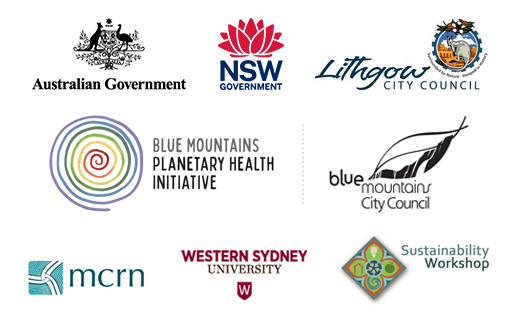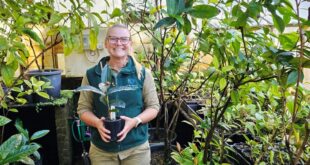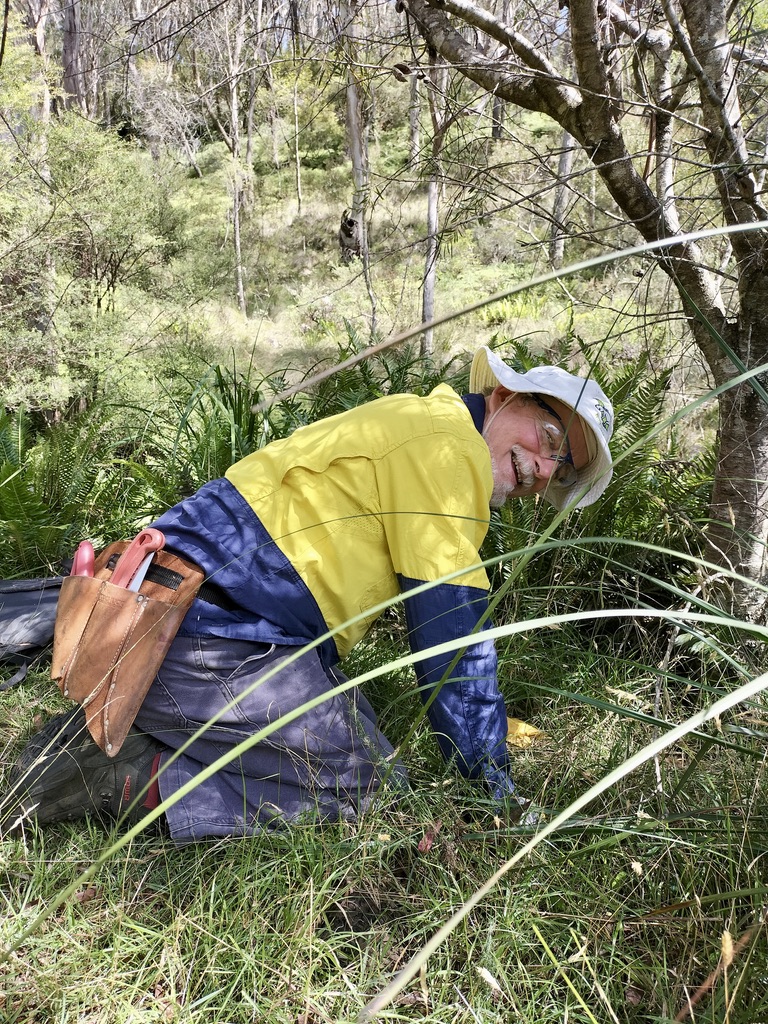
Keith Brister weeding in the Govetts Leap Catchment as part of a Bushcare team
Story and photographs by Tracie McMahon
Keith Brister is on a mission. He and his fellow Bushcare volunteers spent years “achieving the impossible”, protecting Blackheath’s stunning natural bushland, only to see the weeds return when COVID restrictions limited Bushcare. But Keith did not despair. Instead, he asked what else could be done, and set about doing it.
The rain events of 2021 and 2022 created the perfect conditions for weeds. Seed beds were exposed by the 2019/20 bushfires and native vegetation which might otherwise have suppressed the voracious weeds, took time to recover. Past infestations, believed to have been eradicated, re-emerged while perennially problematic areas flourished. Keith feared that Bushcare activities alone would not work. He approached three other passionate volunteers working in the Govetts Leap catchment to strategise. In October 2022, they formed the Govetts Leap Catchment Group.

The iconic Govetts Leap (sometimes referred to as Bridal Veil Falls) tumbling into the Grose Valley
Govetts Leap is a Blackheath icon. Photographers from amateur to professional make the pilgrimage to capture the magnificence of Govetts Leap Brook as it tumbles over the sheer sandstone walls of the Grose Valley. Telephoto lenses are trained on the spray as it catches the light, splitting to rainbows. Sometimes it turns on a sudden upward gust to shower surprised onlookers at Barrow Lookout.
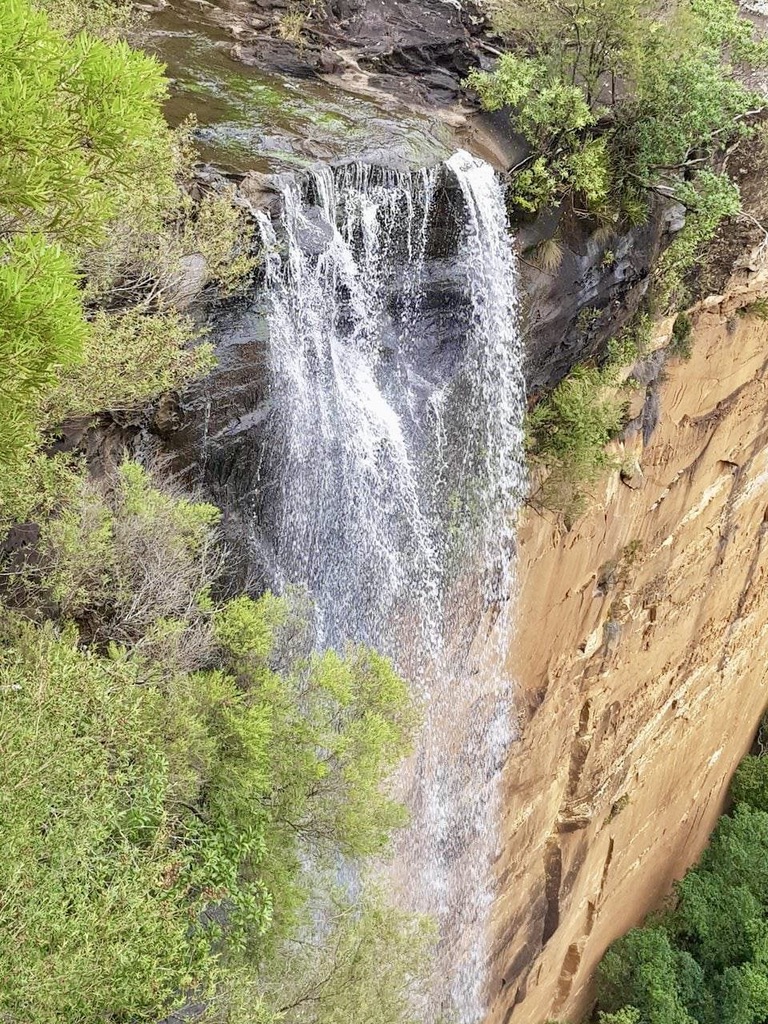
Govetts Leap from Barrow Lookout
But have you ever wondered where that water comes from and what else flows into the valley with all that water?
This waterway is the focus of the Catchment Group. It begins on the eastern side of Blackheath, in an area loosely bordered by Govetts Leap Road, Evans Lookout Road and the Great Western Highway running alongside the Western Railway line. Water flows over land contours from the highway towards the Grose Valley. It traverses roads, homes, reserves, and the Blackheath Golf Course to join the natural watercourse of the Braeside Creek. The Creek joins Govetts Leap Brook in the national park, before cascading into the valley at Govetts Leap (sometimes referred to as Bridal Veil Falls).
The Catchment Group’s vision is to ensure:
All land tenures in the Govetts Leap catchment are managed effectively, in a coordinated manner, and in the long-term, to provide best practice stormwater management, and to control or eliminate weeds that threaten the environment, and particularly the integrity of the adjoining Greater Blue Mountains Area World Heritage property (Govetts Leap Catchment Group vision statement).
In early 2023, Keith asked if I would like to join the Catchment Group as a local resident and fellow Bushcare volunteer. In the thick of removing Tutson (a spreading weedy shrub) from a steep bank on the edge of the Braeside Walking Track, my first instinct was a covert eye roll behind my safety glasses, imagining endless meetings. I asked him: “what are you actually going to do?”
He patiently explained the steps they would take and what they expected to achieve. It was clear that he and the other members had thought about this. They had had already met with stakeholders to ensure their approach was viable. Their plan brought together key parties to ensure gaps created by land management boundaries are addressed. It took Bushcare volunteering to another level.
I wondered why one individual would decide to step-up and what I could possibly offer, as a fledgling Bushcare volunteer. Keith and I agreed to meet, so he could continue his recruitment drive and I could have my questions answered.
Why did you decide to set up the group?
Over years we have done all the work and achieved ‘the impossible’, only to return later to find the return of the same weed escaping from land bordering the Bushcare site or via drainage into the area. I was aware of other catchment groups in the Blue Mountains and spoke to Monica Nugent (Senior Field Officer for Bush Regeneration at the Blackheath National Parks and Wildlife Services), about their activities. She put me in touch with other catchment groups. After thinking it over, I decided to give it a go.
Who else is involved?
The group includes several Bushcare volunteers with extensive experience and knowledge of the area. Cumulatively, the group have been involved in Bushcare and conservation for over one hundred years.
Why do you think this location is critically important?
The catchment is a tributary into the Grose River and Grose Wilderness. If weeds take hold in the Grose Wilderness, the bush as we know it will be lost, replaced with thickets of holly, privet, gorse and broom.

A wall of Broom in flower
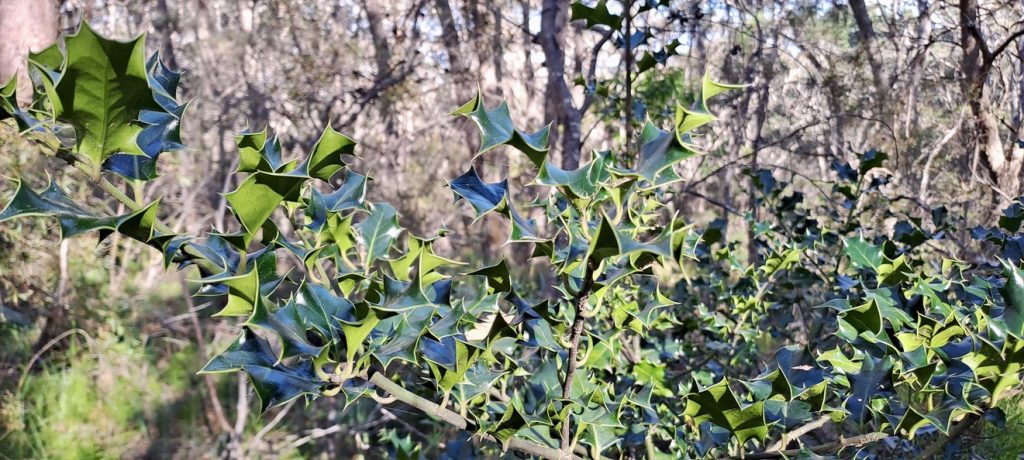
Holly on the verge of Prince George Street, Blackheath. This area is currently being worked by a Blue Mountains City Council Bushcare group.
Why now?
The impact of the 2019/20 bushfires and the absence of Bushcare activities during COVID lockdowns revealed the impact and importance of Bushcare. It became obvious to me that the bush needs us to help it be able to regenerate. All of us, not just National Parks and Wildlife and Blue Mountains City Council, but every land occupier and manager in the catchment.
The ultimate goal of Bushcare is not to keep going but to ‘rewild’ natural areas so that Bushcare is not necessary.
What actions have you taken to date?
We have held public meetings with relevant Blue Mountains City Council and National Parks and Wildlife Services staff as land managers in the area. We invited local MPs, Councillors and Indigenous representatives to attend, and we were fortunate to have a number attend, with others requesting follow up information or meetings. We feel these meetings have opened positive lines of communication around how best to tackle weeds across all land tenures in the catchment.
Action on weeds in the railway corridor is of note. It was agreed we would write to the ministers responsible for road and railway corridors, drawing their attention to prolific weed infestations. This, with follow-up actions and correspondence from Trish Doyle has resulted in treatment of significant blackberry infestations in the railway corridor.

Poster currently on display addressing Cotoneaster and Holly.
The group also decided to begin a high visibility weed awareness education campaign. This involved producing posters for highly visible weeds
The posters were displayed on Blackheath community notice boards. Blackheath Area Neighbourhood Centre (BANC) shared the poster through their social media channels and Blue Mountains Conservation Society assisted by displaying posters at their Blackheath Farmers’ Market stand. To support this action, Blue Mountains City Council provided multiple copies of their weed education booklets ‘Weeds of the Blue Mountains’ for distribution at the Conservation Society stand.
Feedback has been fantastic. Conservation Society volunteers indicated that the posters and booklets provoked conversation, and many booklets were picked up. Response to our actions on the BANC Facebook site was overwhelmingly positive, with posters shared by many individuals and groups. We are currently working on a website, to ensure that all our weed awareness posters are available on an ongoing basis and link the public to other important weed management resources, such as Blue Mountains City Council Weed Management https://www.bmcc.nsw.gov.au/weeds and Sydney Weeds Network https://sydneyweeds.org.au/.
Looking ahead, where do you see the Catchment Group in twelve months?
I am hoping we have a better understanding of how it all works. We would like to have clear lines of communication, so we know who to contact to address urgent weed problems in the catchment, to ensure weeds do not escape into the Grose Valley wilderness.
We also hope to have walked the whole catchment and mapped it to consider problems and how best to strategically address weed issues with land managers in the area.
Finally, we are hoping to increase public knowledge of weeds, so that all land managers including homeowners and occupiers, are aware of the potential impact of plants on the neighbouring bush.
Most people who live in the mountains live here because they enjoy the natural beauty of the mountains. We just want to ensure that natural beauty remains for future generations.
Catchment groups across the Blue Mountains
This is one of several catchment groups operating across the Blue Mountains. Each has been formed by individuals who care deeply about protecting and preserving a specific natural environment connected to a water catchment. While the groups each have a focus unique to the critical issues of their own catchment, they have a common approach, aimed at working collaboratively with all land managers, from householder to government.
The model has grown from understanding that land managers are diverse and that land boundaries are irrelevant to weeds. Weeds are not concerned who owns, or is responsible for, the land on which they grow. Land managers may not understand or have resources to manage a particular problem. The well-worn battle strategy ‘divide and conquer’ is particularly effective for weeds. To win this battle we need to unify, to become weed aware, vigilant and responsive to problems.

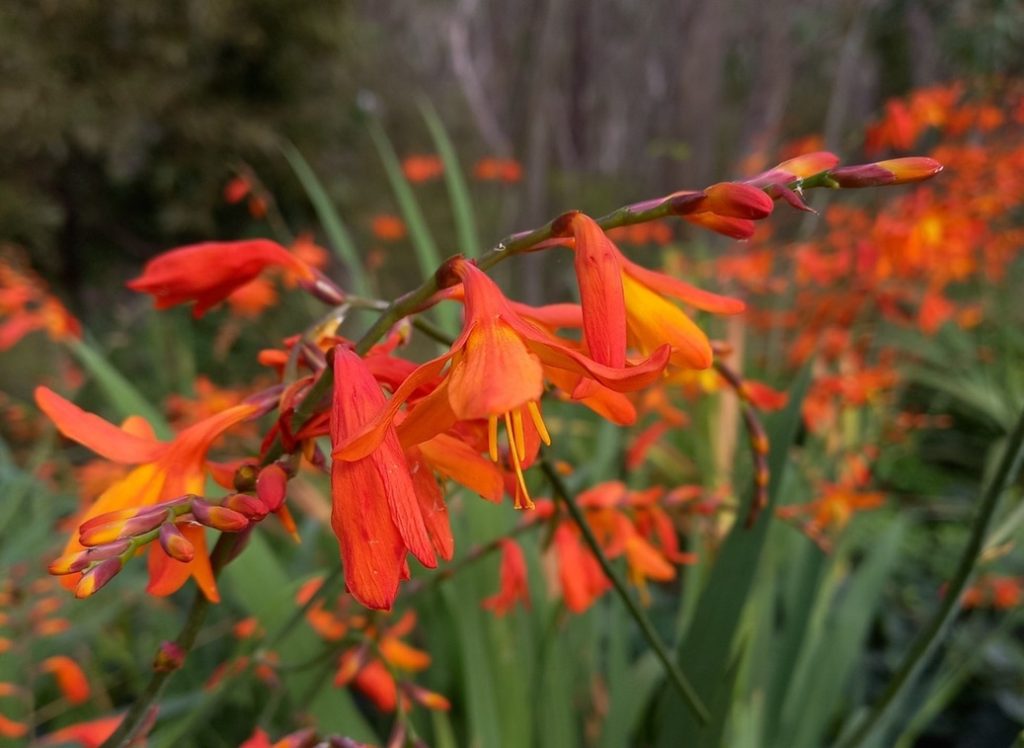

Weeds common in the Govetts Leap Catchment Area. Many of these plants are common in gardens and can be controlled by homeowners. Photos L & R by Tracie McMahon; Centre by Keith Brister
There are things that we can all do, whether that be deadheading agapanthus on a kerbside, joining Bushcare, or pulling up blackberry or holly suckers. Every action helps. I for one, am glad Keith didn’t despair and hang up his trowel. The group now has six members, including myself, and I am pleased to report that meetings are sparing, and actually I find them valuable. If you would like to know more, the Catchment Group can be contacted on govettsleapcg@gmail.com.
This story has been produced as part of a Bioregional Collaboration for Planetary Health and is supported by the Disaster Risk Reduction Fund (DRRF). The DRRF is jointly funded by the Australian and New South Wales governments.
